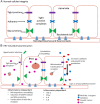How does rhinovirus cause the common cold cough?
- PMID: 26835135
- PMCID: PMC4716235
- DOI: 10.1136/bmjresp-2015-000118
How does rhinovirus cause the common cold cough?
Abstract
Cough is a protective reflex to prevent aspiration and can be triggered by a multitude of stimuli. The commonest form of cough is caused by upper respiratory tract infection and has no benefit to the host. The virus hijacks this natural defence mechanism in order to propagate itself through the population. Despite the resolution of the majority of cold symptoms within 2 weeks, cough can persist for some time thereafter. Unfortunately, the mechanism of infectious cough brought on by pathogenic viruses, such as human rhinovirus, during colds, remains elusive despite the extensive work that has been undertaken. For socioeconomic reasons, it is imperative we identify the mechanism of cough. There are several theories which have been proposed as the causative mechanism of cough in rhinovirus infection, encompassing a range of different processes. Those of which hold most promise are physical disruption of the epithelial lining, excess mucus production and an inflammatory response to rhinovirus infection which may be excessive. And finally, neuronal modulation, the most convincing hypothesis, is thought to potentiate cough long after the original stimulus has been cleared. All these hypotheses will be briefly covered in the following sections.
Keywords: Airway Epithelium; Cough/Mechanisms/Pharmacology; Respiratory Infection; Viral infection.
Figures


Similar articles
-
Effects on the nasal mucosa of upper respiratory viruses (common cold).Dan Med Bull. 1994 Apr;41(2):193-204. Dan Med Bull. 1994. PMID: 8039434 Review.
-
Rhinovirus upregulates transient receptor potential channels in a human neuronal cell line: implications for respiratory virus-induced cough reflex sensitivity.Thorax. 2014 Jan;69(1):46-54. doi: 10.1136/thoraxjnl-2013-203894. Epub 2013 Sep 3. Thorax. 2014. PMID: 24002057
-
Cough and viruses in airways disease: mechanisms.Pulm Pharmacol Ther. 2009 Apr;22(2):108-13. doi: 10.1016/j.pupt.2008.12.022. Pulm Pharmacol Ther. 2009. PMID: 19480062 Free PMC article. Review.
-
Fireside conference 11. Common cold.Rhinol Suppl. 1992;14:228-32. Rhinol Suppl. 1992. PMID: 1327017
-
Mucous hypersecretion and relationship to cough.Pulm Pharmacol Ther. 2013 Oct;26(5):510-3. doi: 10.1016/j.pupt.2013.02.003. Epub 2013 Feb 19. Pulm Pharmacol Ther. 2013. PMID: 23434445
Cited by
-
Associations between COVID-19 and skin conditions identified through epidemiology and genomic studies.J Allergy Clin Immunol. 2021 Mar;147(3):857-869.e7. doi: 10.1016/j.jaci.2021.01.006. Epub 2021 Jan 21. J Allergy Clin Immunol. 2021. PMID: 33485957 Free PMC article.
-
Clinical and Th1/Th2 immune response features of hospitalized children with human rhinovirus infection.J Med Virol. 2020 Jan;92(1):26-33. doi: 10.1002/jmv.25587. Epub 2019 Sep 18. J Med Virol. 2020. PMID: 31475732 Free PMC article.
-
Treatment with the P2X3-Receptor Antagonist Gefapixant for Acute Cough in Induced Viral Upper Respiratory Tract Infection: A Phase 2a, Randomized, Placebo-Controlled Trial.Pulm Ther. 2022 Sep;8(3):297-310. doi: 10.1007/s41030-022-00193-w. Epub 2022 Aug 15. Pulm Ther. 2022. PMID: 35969360 Free PMC article.
-
Managing the supportive care needs of those affected by COVID-19.Eur Respir J. 2020 Apr 23;55(4):2000815. doi: 10.1183/13993003.00815-2020. Print 2020 Apr. Eur Respir J. 2020. PMID: 32269090 Free PMC article.
-
EPs® 7630 Stimulates Tissue Repair Mechanisms and Modifies Tight Junction Protein Expression in Human Airway Epithelial Cells.Int J Mol Sci. 2023 Jul 7;24(13):11230. doi: 10.3390/ijms241311230. Int J Mol Sci. 2023. PMID: 37446408 Free PMC article.
References
-
- Witek TJ, Ramsey DL, Carr AN et al. . The natural history of community-acquired common colds symptoms assessed over 4-years. Rhinology 2015;53:81–8. doi:10.4193/Rhin14.149 - DOI - PubMed
-
- Eccles R, Loose I, Jawad M et al. . Effects of acetylsalicylic acid on sore throat pain and other pain symptoms associated with acute upper respiratory tract infection. Pain Med 2003;4:118–24. doi:10.1046/j.1526-4637.2003.03019.x - DOI - PubMed
-
- Curley FJ, Irwin RS, Pratter MR et al. . Cough and the common cold. Am Rev Respir Dis 1988;138:305–11. doi:10.1164/ajrccm/138.2.305 - DOI - PubMed
-
- Reid DD, Williams RE, Hirch A. Colds among office workers an epidemiological study. Lancet 1953;262:1303–6. doi:10.1016/S0140-6736(53)91373-7 - DOI - PubMed
-
- Braman SS. Postinfectious cough: ACCP evidence-based clinical practice guidelines. Chest 2006;129:138S–46S. doi:10.1378/chest.129.1_suppl.138S - DOI - PubMed
LinkOut - more resources
Full Text Sources
Other Literature Sources
